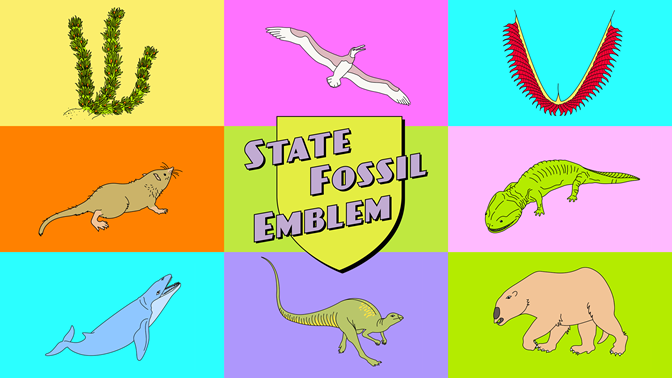Victorian Public to 'Dig Up' a State Fossil Emblem
Voting opens for Victorian residents to select a state fossil emblem for Victoria, with eight locally discovered fossils to choose from.
Today, Museums Victoria launches a public voting campaign to select an official state fossil emblem for Victoria. Eight fossil specimens have been shortlisted by palaeontologists from Museums Victoria, with the Victorian public to have their say via an online voting system.
The fossil specimens will be on display in 600 Million Years in Melbourne Museum’s Science & Life Gallery when Melbourne Museum reopens.
There are currently six official state emblems of Victoria: Leadbeater’s Possum, the Helmeted Honeyeater, the Common Seadragon, Common Heath, our state mineral, gold and our state tartan, but no fossil emblem.
Stemming from the Latin word fossus, which means ‘dug up’, a fossil is the remains of a past organism - such as a plant or a land or sea animal - preserved in rock, soil or amber.
Victoria will join a growing list of states to adopt a fossil emblem, joining New South Wales (Devonian fish Mandageria fairfaxi), South Australia (Spriggina floundersi), and Western Australia (Gogo fish Mcnamaraspis kaprios). Australian Capital Territory recently announced their intent to officially instate the trilobite Batocara mitchelli as their fossil emblem after a public voting campaign.
Lynley Crosswell, CEO and Director, Museums Victoria, said: "We know from our visitors that people of all ages are intrigued by fossils. Our experts have selected eight remarkable specimens from among more than 4 million fossils in the state palaeontology collection – now its everyone else’s turn to choose their favourite to be immortalised as Victoria’s fossil emblem."
Minister for Creative Industries, Danny Pearson, said: "This campaign is a fun and engaging way for people of all ages to learn more about Victoria’s history and the incredible discoveries that have been unearthed by palaeontologists and keen citizen scientists across our state. I encourage everyone to visit Melbourne Museum or jump online to learn more, cast your vote and rock on!"
The shortlisted fossil candidates have been found, or would have lived, in a wide range of regions across the state and encompass a rich spread of organism types from plants, sea animals, and land animals.
The first candidate is Isograptus victoriae, a small 470-million-year-old marine invertebrate found around the Castlemaine and Goldfields areas. This seafloor fossil spells a ‘V’ for Victoria which it was named after, and fossils revealed where the distorted rocks in central Victoria belonged to the same layers. Miners used them to track seams of gold underground.
The second candidate is Baragwanathia, a 400-million-year-old plant found around the Thomson River, west Gippsland, Yea, and Central Victoria. It is one of the world’s first plants to adapt to living outside water, and the first Baragwanathia fossils were found in Victoria.
The third candidate is Bishops whitmorei, a tiny shrew-like mammal that thrived in cool Gondwanan forests amongst polar dinosaurs 130 million years ago, found near Inverloch, south Gippsland. They were found fossilised in ancient riverbeds, along the modern coastline. It took keen eyes to spot the tiny fossils, and painstaking skill to free them from the rock.
The fourth candidate is Koolasuchus cleelandi. Resembling a mix between a newt and a crocodile, this car-sized Cretaceous amphibian had a head the size of a dustbin lid with dozens of ridged fangs. Unique to Victoria and found near San Remo, Gippsland, this ‘relic’ species lived around 125 million years ago.
The fifth candidate is Janjucetus hunderi, a small but fierce whale that lived 25 million years ago off the Victorian coast. Janjucetus is a vivid evolutionary link between ancient whales and modern giants like the Blue Whale. The species was named after the place it was found, Jan Juc, and the person who found the fossil, Staumn Hunder.
The sixth candidate is Pelagornis, a toothed ocean-going bird with a wingspan twice the size of a living albatross - a huge 6 metres wide! Its lineage roamed the world’s skies from just after the extinction of the dinosaurs until about 2.5 million years ago. 5-million-year-old fossils of Pelagornis were discovered from bayside Beaumaris, Victoria.
The seventh candidate is Palorchestes azael, an unusual marsupial heavier than a buffalo living from 10 million years ago until only 40,000 years ago. Its teeth and jaws look like those of a giant kangaroo, but Palorchestes was more closely related to wombats. The best-known fossils of Palorchestes come from limestone caves in Victoria, from Strathdownie in the west to Buchan in the east.
The eighth fossil is Leaellynasaura amicagraphica, a small herbivorous polar dinosaur from the Early Cretaceous period, discovered in Dinosaur Cove near Great Otway National Park. It was named after the daughter of palaeontologists Tom Rich and Patricia Vickers-Rich and is one of the few dinosaur species to be named in honour of a woman.
Public voting opens on Wednesday 11 August 2021 and closes at 5pm Monday 4 October 2021. Following the public vote, the winner will be submitted to Government for official endorsement after which our new fossil emblem will be announced.
Find out more and cast your vote for Victoria’s State Fossil Emblem here:
Images, videos and further information is available.
Interviews are available with:
Dermot Henry, Head of Sciences, Museums Victoria
Museums Victoria's experts for each fossil

